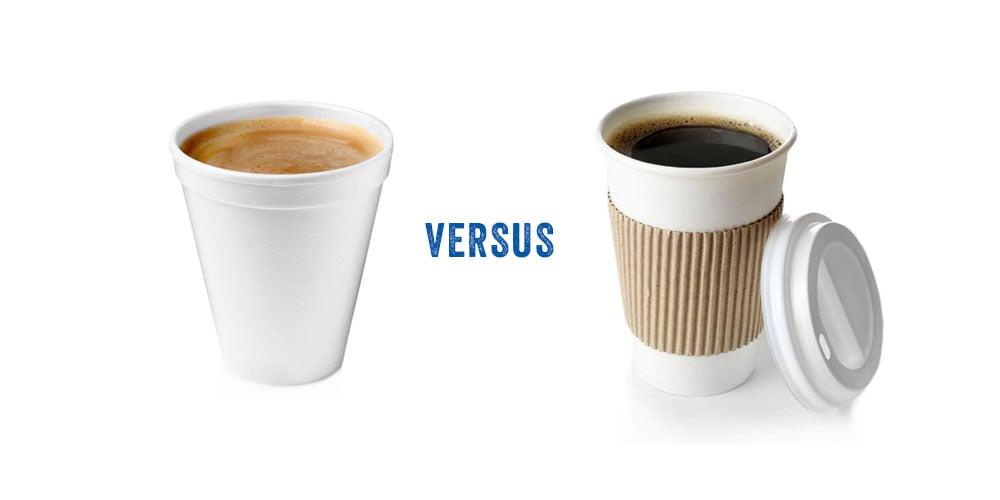Foam Insulation vs. Fiberglass: A Comprehensive Comparison to Coffee Cups


When it comes to insulating your home, there are numerous options to choose from.
One common debate revolves around the choice between fiberglass and foam insulation.
While we specialize in premium injection foam insulation, we also know about other home insulation options, like fiberglass.
Both fiberglass and foam insulation have advantages and disadvantages, so let’s dive into a detailed comparison to help you make an informed decision for your home - by comparing gas station coffee cups.
Cost-Effective vs. Superior Performance
First and foremost, let's address cost.
Fiberglass insulation is notably less expensive than foam insulation. If your primary concern is the upfront cost, fiberglass may seem like an attractive option. However, it's crucial to consider long-term value.
Foam insulation outshines fiberglass in terms of performance. It excels at effectively insulating your home, providing superior energy efficiency. Unlike fiberglass, foam insulation doesn't degrade over time, ensuring it remains effective for the lifetime of your building. This longevity can offset its initial cost, making it a cost-effective choice in the long run.
Longevity and Maintenance
Fiberglass's main drawback is its tendency to break down and separate over time.
The fibers in fiberglass insulation will pull apart and degrade due to gravity and air movement, ultimately requiring replacement or additions over the years. This can significantly increase the cost over time, impacting your overall investment.
In contrast, foam insulation is designed to last for the lifetime of your home. Once installed, it remains in place, delivering consistent performance and eliminating the need for regular maintenance. This extended lifespan makes foam insulation a hassle-free option for homeowners.
Indoor Air Quality and Health Considerations
Fiberglass insulation can be irritating to some people.
If you've ever handled fiberglass, you know it can cause itching that lasts for days.
Moreover, the fibers in fiberglass can break apart over time and become airborne inside your home. This can find its way into your duct system and circulate throughout your home, potentially causing discomfort and health issues.
Foam insulation, on the other hand, doesn't have these downsides. It doesn't deteriorate or break down over time, ensuring indoor air quality remains unaffected. This aspect makes foam insulation a healthier choice for your home.
Availability and Installation
Fiberglass insulation is readily available for homeowners to purchase at most hardware stores, making it an accessible option for DIY projects.
In contrast, foam insulation often requires the expertise of a professional contractor. While some foam insulation products are available at hardware stores, larger-scale installations usually require hiring a contractor.
Performance Comparison: Paper vs. Styrofoam Cups
Now for the moment you’ve all been waiting for - a practical comparison between fiberglass and foam insulation using coffee cups.
A paper cup, similar to fiberglass, isn't efficient at stopping heat transfer. It requires an additional sleeve to insulate your hand from hot beverages.
On the other hand, a Styrofoam cup, like foam insulation, excels at stopping heat transfer, eliminating the need for additional insulation.
The same principle applies to coolers. Foam-insulated coolers maintain temperature better than those with fibrous insulation.
So, what about when it’s hot in the summer, and you just want to keep your beverage cool or your home from feeling like an oven?
Well, the same comparison works no matter the time of year. The foam cup works to keep the beverage cool, just like foam insulation keeps a house cool in the summer.
Choosing the Best Home Insulation for Your Project
In the foam insulation vs. fiberglass debate, the choice ultimately depends on your priorities.
If cost and availability are your primary concerns, fiberglass may be suitable, particularly for small DIY projects. However, foam insulation is optimal for long-term energy efficiency, minimal maintenance, and superior performance.
Consider foam insulation if you want to enhance your home's comfort and energy efficiency. Connect with a local RetroFoam dealer to learn more about how foam insulation can transform your living space.
Remember, building is a science, and choosing the right insulation material can profoundly impact your home's efficiency and comfort.
Related Articles
Sealing the Comfort Gap: Treating Your Home Like a Fridge
What is Air Sealing Your Home with RetroFoam Insulation?
About Eric Garcia
Eric brings his knowledge and training in building science, training in spray and injection foams from the manufacturers, more than eight years installing foam insulation, as well as selling and managing in the foam insulation industry. He is also BPI and Dale Carnegie certified and has taken several building science courses, including air sealing and building envelope. Eric is the Professor of Foam on our educational YouTube series Foam University. Even when Eric is off he is usually still “working” or thinking about work, but when he can get away he enjoys camping, hiking, hunting, and woodworking.



